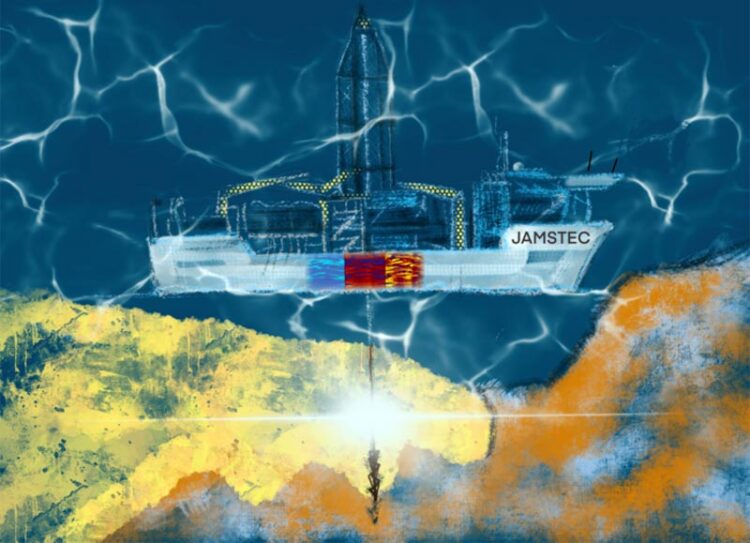Finding faults deeply stressful

Japan Trench Fast Drilling Project (JFAST) drilling through the plate boundary fault that ruptured; the research team collected core samples to analyze post-earthquake stress.
Credit: KyotoU Global Comms / Jake G Tobiyama
First investigation of stress state below plate boundary fault of Tohoku earthquake.
The great 2011 earthquake that caused the tsunami in northeastern Japan is still remembered for its destructive power.
Also known as the Mw 9.0 Tohoku earthquake, the seismic nature of this calamity was not initially entirely clear. While earthquakes resulting from built-up tectonic stress in reverse faulting had only been partially released. In previous studies where complete releases have been posited, the hypothesis was based on seismicity observation and simulation, or on direct stress measurement data above the fault only by using log data.
Now, a team of researchers at Kyoto University has found evidence that a complete stress release may have contributed to the record-breaking event.
“The minor differences between maximum and minimum post-earthquake horizontal stresses near the fault suggest that the Tohoku earthquake occurred upon a complete stress release,” explains lead author Weiren Lin.
The team found that both sedimentary formations above and below the plate boundary fault lie in the stress state of normal faults in which vertical stress is greater than maximum horizontal stress.
“Knowledge about stress changes before and after this earthquake, both above and below a gently dipping fault, can provide us insights into how fault slipping caused the ensuing tsunami,” the author reflects.
Lin’s team was able to collect data for the stress state above the source fault of the Tohoku earthquake, at the boundary between the North American plate and the subducting Pacific plate. However, geophysical data for the stress state below this zone was unreliable.
To address this problem, the team studied one of four drill core samples collected by the Japan Trench Fast — or JFAST — Drilling Project from below the source fault and was the first to successfully reveal the stress state at that depth.
“Our new data show good consistency with previous results above the fault, suggesting that combining geophysical data and core samples to comprehensively investigate stress states is effective.”
The paper “Three-dimensional stress state above and below the plate boundary fault after the 2011 Mw 9.0 Tohoku earthquake” appeared on 9 November 2022 in Earth and Planetary Science Letters, with doi: 10.1016/j.epsl.2022.117888
About Kyoto University
Kyoto University is one of Japan and Asia’s premier research institutions, founded in 1897 and responsible for producing numerous Nobel laureates and winners of other prestigious international prizes. A broad curriculum across the arts and sciences at both undergraduate and graduate levels is complemented by numerous research centers, facilities, and offices around Japan and the world. For more information, please see: http://www.kyoto-u.ac.jp/en
Journal: Earth and Planetary Science Letters
DOI: 10.1016/j.epsl.2022.117888
Method of Research: Experimental study
Subject of Research: Not applicable
Article Title: Three-dimensional stress state above and below the plate boundary fault after the 2011 Mw 9.0 Tohoku earthquake
Article Publication Date: 9-Nov-2022
COI Statement: The authors declare that they have no known competing interests.
Media Contact
Jake G. Tobiyama
Kyoto University
tobiyama.gakuji.6y@kyoto-u.ac.jp
All latest news from the category: Earth Sciences
Earth Sciences (also referred to as Geosciences), which deals with basic issues surrounding our planet, plays a vital role in the area of energy and raw materials supply.
Earth Sciences comprises subjects such as geology, geography, geological informatics, paleontology, mineralogy, petrography, crystallography, geophysics, geodesy, glaciology, cartography, photogrammetry, meteorology and seismology, early-warning systems, earthquake research and polar research.
Newest articles

NASA: Mystery of life’s handedness deepens
The mystery of why life uses molecules with specific orientations has deepened with a NASA-funded discovery that RNA — a key molecule thought to have potentially held the instructions for…

What are the effects of historic lithium mining on water quality?
Study reveals low levels of common contaminants but high levels of other elements in waters associated with an abandoned lithium mine. Lithium ore and mining waste from a historic lithium…

Quantum-inspired design boosts efficiency of heat-to-electricity conversion
Rice engineers take unconventional route to improving thermophotovoltaic systems. Researchers at Rice University have found a new way to improve a key element of thermophotovoltaic (TPV) systems, which convert heat…



